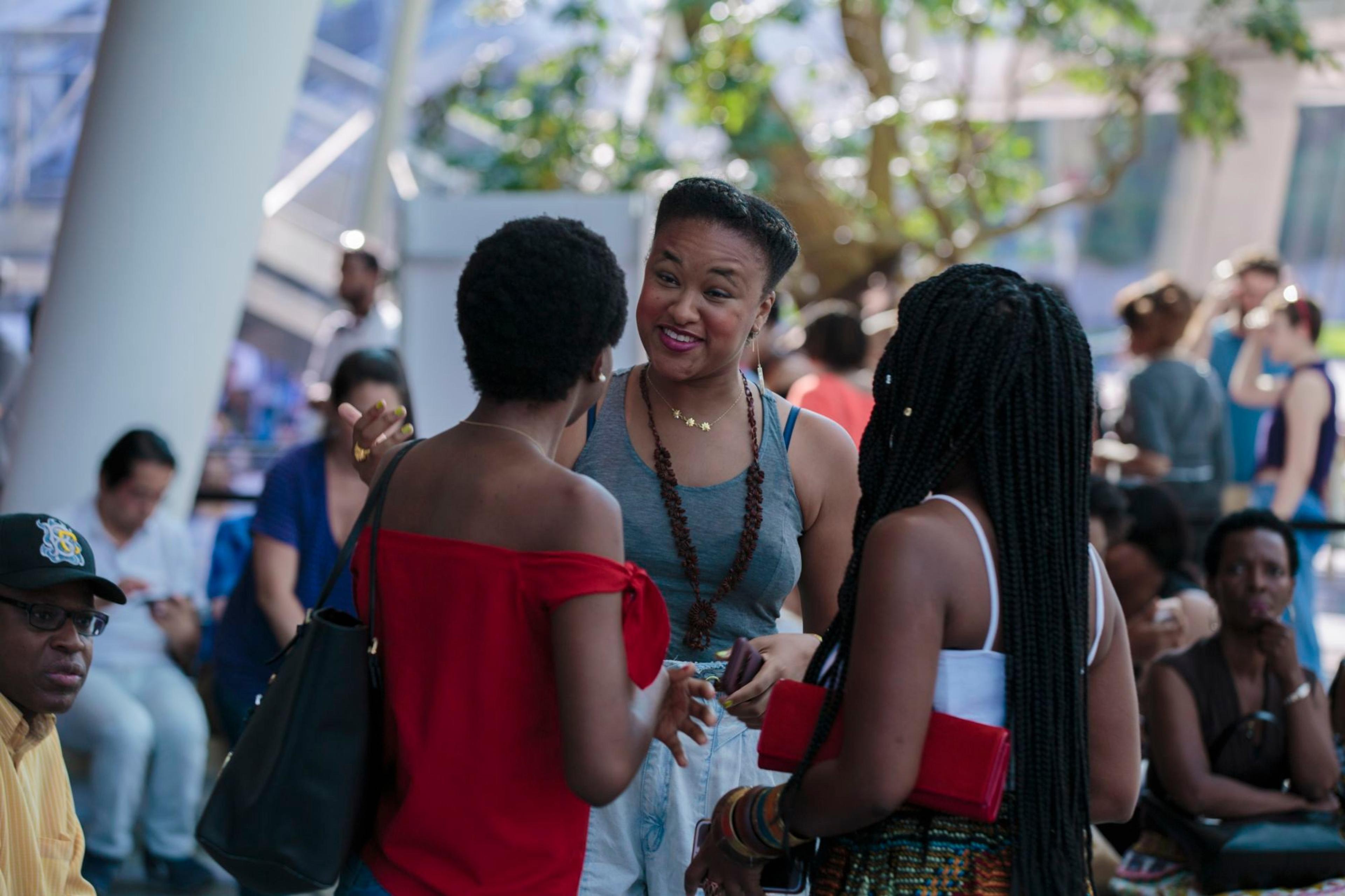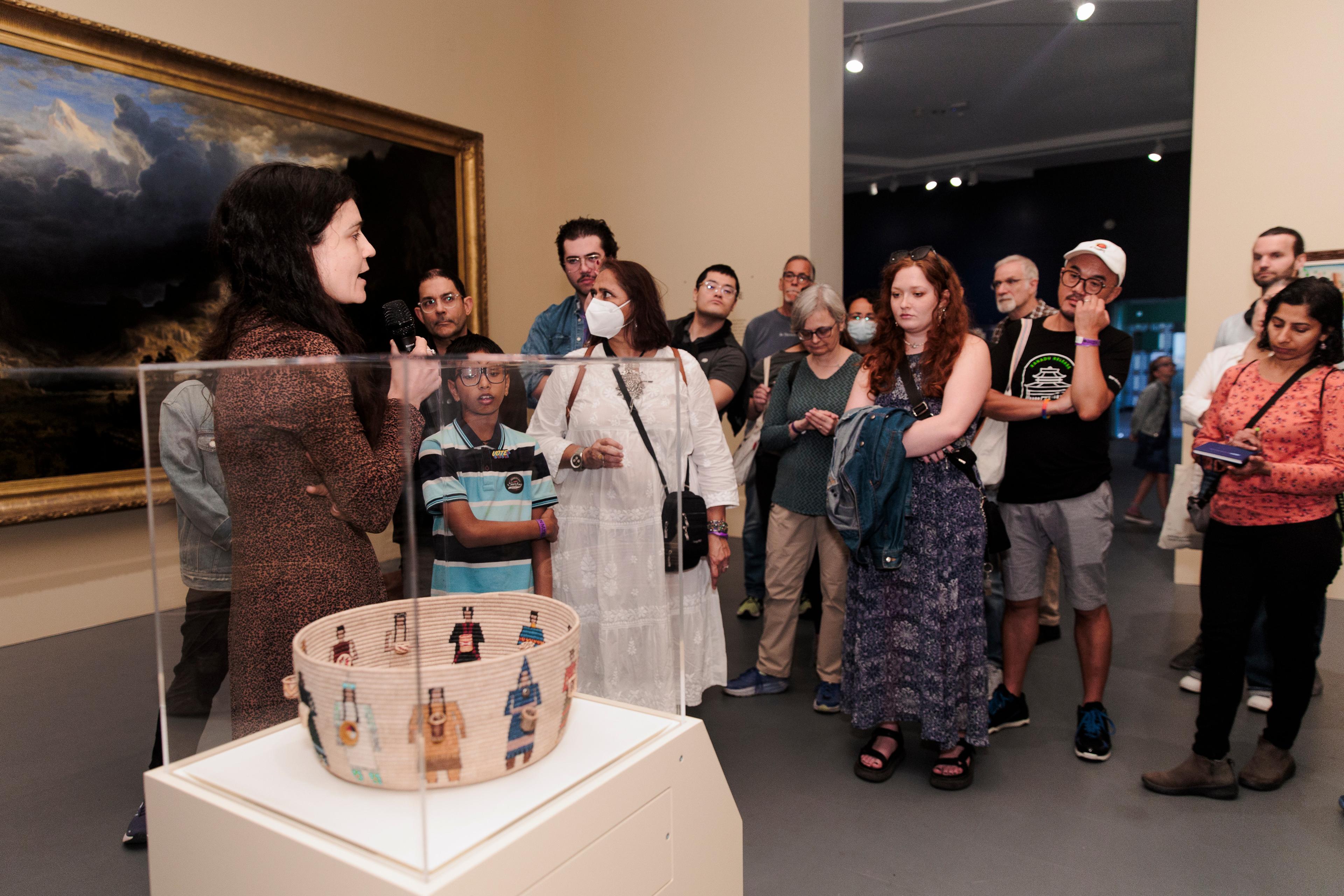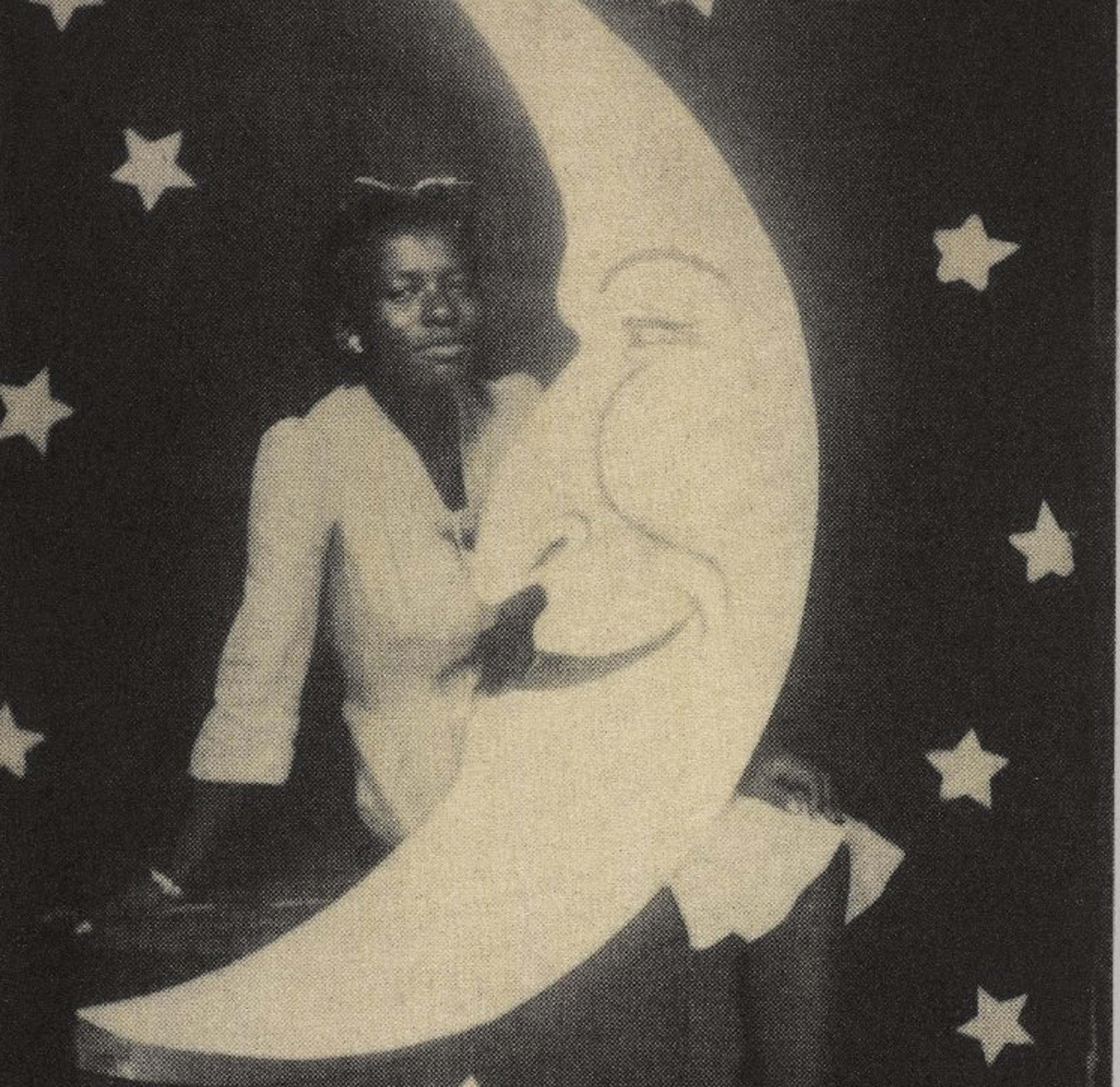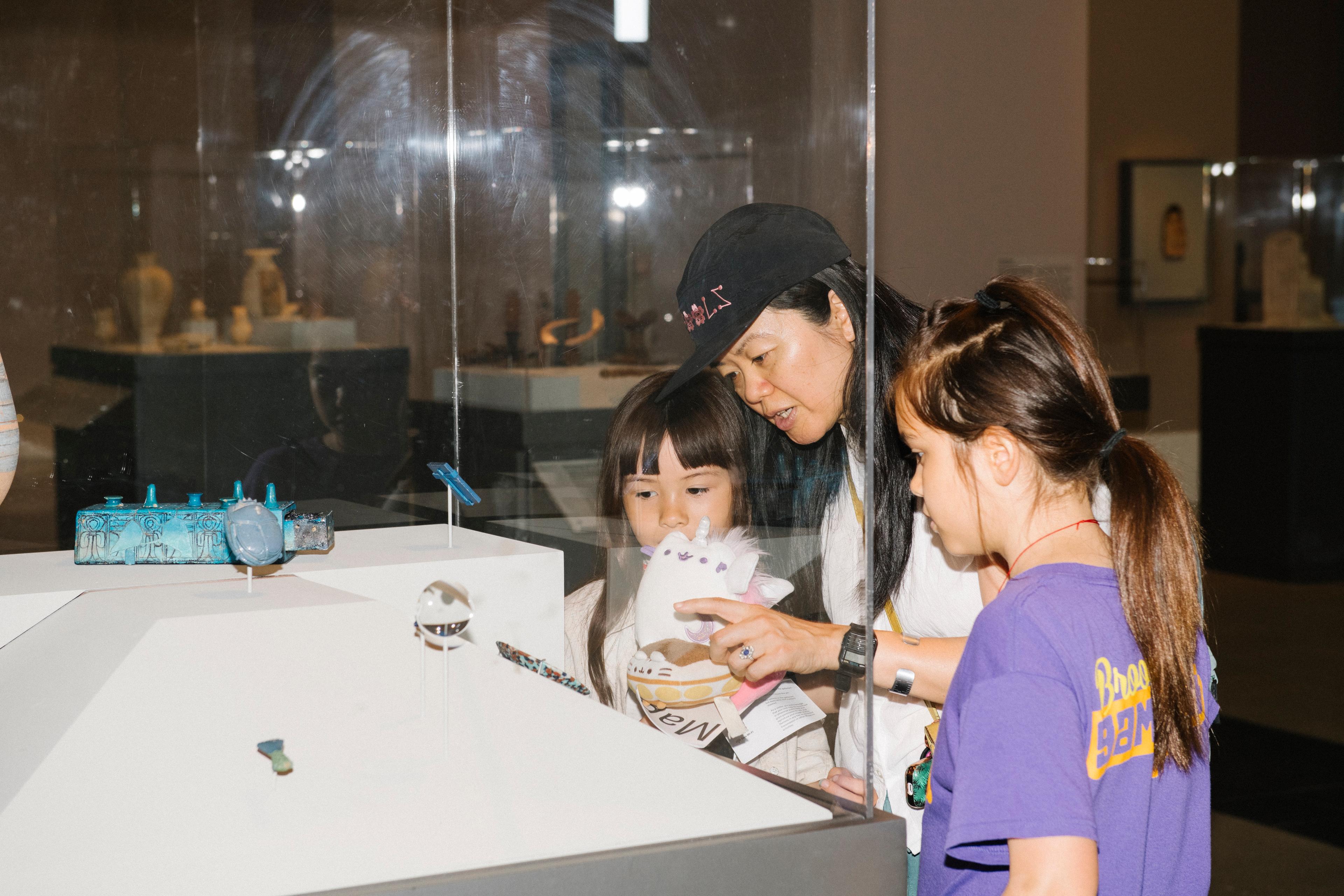Groups’ Guide to the Brooklyn Museum

Visiting the Museum with a group? Here are a few artworks to seek out and discuss.
by Jessica Murphy
April 3, 2024
Even before you enter the Brooklyn Museum, it’s clear that this is a space for groups, gatherings, and connection. The plaza in front of the Museum has long been a popular spot for all kinds of public assembly, from parades to protests; the Museum’s public programs, especially First Saturdays, are produced with and for our local Brooklyn community.
This guide is for visitors attending the Museum in groups and looking for collection items that inspire connection. The following objects are just a small selection of the conversation starters on view throughout the building, highlighting community and social life across the span of art history.
Raise the questions and prompts associated with each work to your group, or come up with your own discussion points! Find your way with our floor directory.
Lobby
Triumph of the Vanities II, Contemporary Art
This large-scale painting by British artist Cecily Brown was first displayed in the lobby of the Metropolitan Opera’s grand modernist building at Lincoln Center in Manhattan. It shows a closely packed, swirling crowd attending a cultural event, and its palette of reds and yellows intensifies the mood of heated excitement.
Can you pick out details—faces, shoulders and arms, feet climbing stairs, and even a few bow ties? (Fortunately, there’s no formal dress code for groups at the Brooklyn Museum!)
2nd Floor
Wine Jar with Eight Immortals, Arts of Asia
The figures encircling this vessel are legendary heroes known in Daoist literature as the Eight Immortals. Each immortal has his own origin story and unique powers, but they are usually shown in a group, united by their shared superhuman abilities to walk on water and move among the clouds. This jar was made to hold wine, and it would have served as a focal point and conversation starter for people dining and drinking together.
What is your superpower and when was the last time you used it?
Buddhist Sculpture of the Himalayas, Arts of Asia
Look at the Tibetan devotional sculptures in the case titled “Buddhist Sculpture of the Himalayas,” unified by their precious materials and religious function. Look at their hands and the objects they hold to learn about each figure’s identity. Wise Manjushri brandishes a sword (to cut through ignorance), compassionate Padmapani leans his left arm on a tall lotus blossom, and Vasudhara, the Buddhist goddess of wealth, holds assorted gifts in her six hands.
If you were depicted as a sculpture, what would you hold to symbolize your own strengths and special qualities?
3rd Floor
Apkallu-figure and King Ashur-nasir-pal II, Egyptian, Classical, Ancient Near Eastern Art
These ancient stone panels are fragments of a massive mural from the palace of the Assyrian King Ashur-nasir-pal II, in Nimrud, Iraq (formerly known as Kahlu). Their impressive decorations praise Ashur-nasir-pal and celebrate the prosperity of his reign. The king—identified by his boxy headdress—is accompanied by a procession of supernatural beings called apkallu, or “genies.” Together, they protect the king and perform a symbolic rite of pollinating sacred trees.
What details do these figures have in common? What differences can you spot?
Statue of a Family Group, Egyptian, Classical, Ancient Near Eastern Art
The sculptor of this family portrait took artistic license to help visually communicate something about the people you see. The largest figure is likely Irukaptah, an ancient Egyptian priest and high-ranking official. His large size indicates that the sculpture centers on him—it was probably designed for his tomb—while his wife and son take on a supporting role. Depicted much smaller and offering a loving embrace, Irukaptah’s wife wears a dress and wig that are typical for a woman of her status. In addition to his small stature, the nude figure can be identified as a child by his sidelock of hair and his gesture, both signs of youth in ancient Egyptian art.
Get your group together for a Museum selfie (no flash, please) and pose in ways that express your identities.
4th Floor
Weil-Worgelt Study, Decorative Arts and Design
This chic interior was designed for the home of Mr. and Mrs. Milton Weil, a couple who lived in an elegant apartment on Park Avenue in the late 1920s and 1930s. Everything in this room—the woodwork of the walls, the furniture, the lighting fixtures—was designed in the style, new at the time, that would later be called Art Deco.
Take a look at the far corner of the room, and you’ll spot a narrow door opened to reveal a hidden bar inside. If you visited the Weils for a cocktail party, where would you choose to sit?
Five-Piece Set, Decorative Arts and Design
Speaking of cocktails, just across our Decorative Arts and Design corridor from the Weil-Worgelt Study, you’ll spot a shiny silver-plated ice bucket with matching stemmed glasses. Despite—or because of—the prohibition of alcohol in the United States in 1920–33, cocktails were a popular offering at upscale social gatherings. This set, with its industrial materials and geometrical shapes, was very modern in 1928 and would have been enjoyed by a group of trendy tipplers.
What kind of drinks would you serve each other with this set, and what other objects in these design cases would you want to use at a party?
If you proceed to the end of the corridor and turn right, you can look down into the Museum’s historic Beaux-Arts Court. This space was designed to allow natural lighting to filter down from the skylights, through the glass floor. It’s frequently used for public programs including musical performances, family art-making sessions, and dance parties—perfect for a group outing!
The Dinner Party, Feminist Art
This work is meant to be experienced as a walk through history (or “herstory”), so take some time to circulate around it. Groundbreaking feminist artist Judy Chicago envisioned The Dinner Party as a monument, a symbolic gathering, and a challenge to artistic and historical patriarchies that erased women’s contributions. Not only is The Dinner Party a fantasy group portrait, but it was also a collaborative work: an extensive team of artisans and researchers participated in its creation.
If you were helping to plan this imaginary dinner, which woman or women from history would you invite?
5th Floor
Winter Scene in Brooklyn, American Art
When Francis Guy painted Front Street from his studio window around 1820, downtown Brooklyn was a bustling neighborhood experiencing a moment of transformation: the older farms of this waterfront area were being surrounded by new buildings and commercial businesses. Guy portrayed his real-life neighbors, who ranged in age, race, social status, and profession.
See if you can identify an architect (holding his L square), farmers, shopkeepers, a judge, and a chimney sweep.
Around the building

When you leave the galleries, take a look out the window you’ll pass just before you reach the elevators. You’ll be able to see nearby Mount Prospect Park, nestled between a trio of cultural institutions: the Brooklyn Public Library, the Brooklyn Botanic Garden, and, yes, the Brooklyn Museum. It’s a perfect spot for any group of Museum visitors to stroll or sit before heading home.
Jessica Murphy is Manager of Group Experiences at the Brooklyn Museum.












